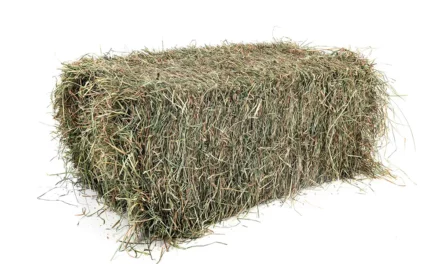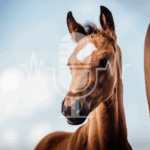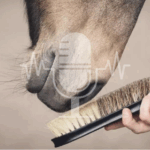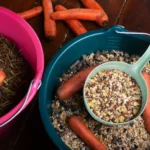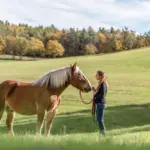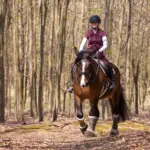Breeders are slowly getting ready for this year’s foal season. As soon as the little ones are born, they usually get a premium spot on the breeder’s website to attract potential buyers. And honestly, what could be cuter than a long-legged youngster tottering around the paddock beside its dam? Buying a horse is always an emotional decision, and more often than not people end up taking home exactly the horse they hadn’t originally been looking for. With foals, common sense tends to fade even faster than with adult horses. That’s why it’s important to carefully think through a few points before browsing sales websites for your future family addition or potential sport prospect. Doing so can save you a lot of work, stress, and health issues later on.
What is the horse’s intended future use?
Die verschiedenen Rassen sind vom Menschen ja nicht ohne Grund so gezüchtet worden. Sie mussten unterschiedlichen Leistungsanforderungen gerecht werden und entsprechend hat der Mensch sie nach Gebäude und Charakter für die Zucht gewählt.
Die verschiedenen Rassen sind vom Menschen ja nicht ohne Grund so gezüchtet worden. Sie mussten unterschiedlichen Leistungsanforderungen gerecht werden und entsprechend hat der Mensch sie nach Gebäude und Charakter für die Zucht gewählt.
Different breeds were developed by humans for a reason. They had to meet specific performance requirements, and breeders selected them accordingly for conformation and character.
Most draft horses, for example, were not bred as riding or carrying horses but as pulling horses. Their hindquarters are built to push powerfully backwards (essential for heavy draft work) but not to step underneath the body and carry weight effectively.
No horse is done a favor by being bought as a riding horse simply because the rider carries a few extra pounds and assumes that a heavy horse must be suited for heavy work. Yes, such horses are bred for heavy pulling work—but not necessarily for heavy carrying work. A warmblood from dressage lines will generally struggle more with jumping than one bred from jumping lines. Even though no one rides “on paper,” the breed and breeding lines still say a great deal about what a horse will later be suited for. Of course, there are exceptions: Norikers who master piaffe perfectly, or warmbloods who shine in western disciplines. But choosing such a mismatch makes the training path significantly more difficult—for both horse and rider—than selecting an animal originally bred for the intended purpose and discipline.
All too often, horses simply cannot meet their rider’s expectations due to their breed or conformation. When that happens, frustration and disappointment on both sides are almost inevitable.

What can I offer the horse?
Owning a young horse does not simply mean finding a boarding stable and assuming that everything else will somehow fall into place. It begins with choosing a good rearing facility, which should be visited in advance and where a place should ideally be reserved.
This is often where the first challenge arises: the best facilities with large pastures and proper feeding are usually so far away that regular visits are not possible.
Am I willing to place my horse in a stable that I might only visit every three to six months on weekends, but where the horse will be perfectly cared for? Or do I prefer to have my horse within reach at all times and start applying my new horsemanship skills to the weanling from the very beginning?
Good rearing facilities with large areas of land are rarely found close to where owners live—owners who, after all, need to work in order to finance their horse. In typical urban areas, riding stables are far more common.
The biggest mistake is placing a weanling or young horse in a riding stable for its rearing. Weanlings belong on a pasture with other youngsters of the same age and, ideally, some older horses in the group to maintain order. Under such conditions, the result is a well-socialized, sure-footed horse with a healthy musculoskeletal system and proper manners.
In a riding stable, both play companions and the generous space of large pastures are missing. Horses raised this way often have much more difficulty later on finding balance under a rider and coordinating their feet. Due to limited turnout and a lack of play stimulation, they also tend to lag behind their peers in physical development.
Once a good rearing facility has been found, the young horse can simply be allowed to grow up. A yearling does not need to learn the entire groundwork repertoire of a future riding horse. Horses are not at a disadvantage in their learning ability just because they begin training at the age of four to six. That is still soon enough to start work.
And this leads to the next question: do I have the skills and experience required to train a young horse myself?
Starting a horse under saddle is not simply a matter of sitting on it. Most horses will tolerate that fairly calmly. Training a young horse, however, requires a great deal of experience with many different horses in order to respond to individual character and physical challenges and to provide the right corrections.
Only a correctly trained horse will be able to carry its rider without gradually damaging its own musculoskeletal system. If the owner cannot train the horse themselves, the question arises whether there is enough budget to pay a professional trainer. And is there a trainer near the chosen stable who has time and is willing to work together with the owner to develop the horse accordingly? Even if a young horse is sent to a trainer, after the usual three months it is far from “finished”—training continues over several years before the horse truly carries a rider correctly. Competent support nearby is essential throughout this process.
And good trainers naturally come at a cost. If that cannot be afforded, it may be wiser to consider buying an already mature, well-trained horse instead.
A common argument is that with an older horse one never knows what negative experiences it may have had, and that it could turn out to be a “difficult” horse in the stable.
Yet this risk also exists with a young horse—it may either have an inherently challenging character or encounter a traumatic experience at some point in its life.
The best approach is to realistically assess one’s own ability to train a horse from the very beginning and then choose a horse that matches current riding skills.
All too often, a young horse is purchased only for the owner to realize that they are overwhelmed by the training, or to later recognize that nearly every possible mistake was made along the way. In the end, it is the horse that pays the price for such overestimation.
The mare’s feeding shapes the foal’s health
One aspect that is far too rarely considered is the future health of a young horse. Many people assume that everything must automatically be fine when buying a foal, since nothing could have gone wrong yet.
This is not the case. As a Chinese proverb says: “The mother of health is the intestine.” The large intestine of a foal is still “sterile” at the moment of birth. Over the first four to five months of life, the foal builds up its large-intestine microbiome (“gut flora”) by regularly eating the droppings of the dam.
This is not the case. As a Chinese proverb says: “The mother of health is the intestine.” The large intestine of a foal is still “sterile” at the moment of birth. Over the first four to five months of life, the foal builds up its large-intestine microbiome (“gut flora”) by regularly eating the droppings of the dam.
A wild mare with a disturbed gut flora will not conceive, because her body cannot extract enough energy from the basic forage to sustain a pregnancy.
The situation is quite different under modern breeding and management conditions. Through specific supplementary feeding, even mares with severely disturbed large-intestine colonization are still able to become pregnant. For the foal, however, this means that from the very first day it ingests the faulty microorganisms of its dam, which then settle in its large intestine. Whatever becomes established in the large intestine during the first four to five months will never fully disappear.
If the dam has a disturbed intestinal environment, the foal will never have the chance to develop a healthy gut flora. In such cases, one can assume that the foal will become a lifelong patient requiring constant therapeutic support to prevent serious metabolic imbalance.
Broodmares of all breeds (!) should never be fed silage-based forages (such as haylage or silage). They should have continuous access to good-quality hay.
Concentrated feed should be avoided entirely in robust breeds, and kept moderate in warmbloods, ideally limited to plain grains such as oats or crushed barley. Concentrated feeds should not contain soybean meal, and feeds such as carrots, apples, beet pulp, and other materials that promote faulty microbial growth in the large intestine should not be fed, or only in very limited amounts.
Even if the dam’s feeding appears appropriate, it is important to question whether she suffers from metabolic disorders.
An overweight pony mare with insulin resistance will very likely pass this condition on to her foal, meaning that the buyer is essentially acquiring a foal already predisposed to EMS. A mare with sweet itch or chronic diarrhea (fecal water) is suffering from a disturbed gut flora, and in such cases the foal will very likely develop health problems. Deciding to take on such a lifelong patient requires careful consideration, as the cost of therapy over the years can become substantial.
That money could be invested far more sensibly in a healthy horse, in good training, and in a better stable that provides species-appropriate management and feeding.

A horse’s basic character does not change
“Ah, we’ll manage somehow…” often belongs to the famous last words of horses that eventually end up being passed on to so-called “experienced horse people.”
Of course, many things can be worked on, but a horse’s fundamental character usually remains the same. It is important to consider from the outset whether that character is truly compatible, since one’s own basic temperament also does not change.
For example, if the rider is rather anxious, the spirited Arabian may make the heart beat faster—but after the third painful fall from the beloved horse, it is unlikely that there will still be the courage to get back on. Conversely, a rider with a calm, analytical personality may quickly be driven to frustration by a horse that is emotionally volatile.
It is, however, necessary to clearly distinguish between character and upbringing. And upbringing does not only begin at the moment of purchase. The dam has been raising the foal from the very first day, modeling behavior.
Is the dam people-oriented? Or indifferent toward interaction with humans? Or perhaps even aggressive? Foals often imitate such behaviors at a very early stage, which in turn strongly shapes the way they interact with people later on.
If the foal already has a naturally anxious character and the dam also signals that humans are not to be trusted, then what arrives in the stable is a real “project.”
This raises the questions: am I willing and able to take on such a project horse? Do I have the time to build a relationship with the horse over several years through trust-building measures? Can I provide the security needed so that the horse sees me as a reliable leader and learns to trust me?
The same applies to the “wild one” raised by an aggressive dam.
It can easily happen that by the age of three, a horse begins to bite, kick, or rear. The question is whether the owner is truly able to educate such a horse consistently over the following years so that both can get along without the situation becoming dangerous for either party—and without resorting to measures aimed at “breaking” the horse. If the owner has a stressful job and is simply looking for a calm hacking horse, then the high-blooded young stallion with fiery temperament may be beautiful to look at, but is not the right choice.
Anyone who takes some time to study basic character types (see for example Recognize Your Horse in the 5 Elements, Crystal Verlag) and observes mare and foal more closely will be far less likely to experience an “unwelcome surprise” when it comes to daily handling or starting the horse under saddle. After all, looks alone are not everything in a horse.
Hand-reared foals, slaughter rescues, and other “special cases”
Many foals offered for sale have not had the straightforward start in life one might ideally wish for.
If the dam of a foal has died early or has rejected it, the foal is usually raised as a “bottle baby,” meaning hand-rearing by humans. For the foal this is, of course, a stroke of luck—in the wild it would starve—but from a behavioral perspective such rearing is often far from simple.
For orphan foals, it is vitally important that they are kept in a socially well-functioning group where other horses consistently teach them boundaries. This is usually only found in herds that have been stable for years and have a reliable herd leader.
Unfortunately, these foals are all too often taken out of the group because the other horses appear too rough with them and there is fear of injury. Yet humans cannot replicate equine body language, nor are they as consistent in setting boundaries as a herd would be. The result is often an adult horse that behaves with little sense of distance toward people and shows significant social deficits with other horses. This early learning is rarely caught up later, leaving such horses outsiders among their peers. In the long term, taking the clingy orphan into the household—almost as if onto the sofa—does not do it any favors.
Slaughter foals are also increasingly rescued by horse enthusiasts. Often these are Haflingers, Freibergers, or draft horses that end up in private ownership.
For the individual foal, it is of course a stroke of luck to escape the slaughterhouse. But there is often a reason why some foals were destined for slaughter in the first place. Quite frequently, this means taking on a horse with severe health problems.
Foals bred exclusively for slaughter are generally neither fed nor kept in a way appropriate to their species. They are often housed with their dams in pens that are far too small for their musculoskeletal system to develop properly. As a result, deformities such as contracted tendons, upright pasterns, club feet, or other conformational faults may develop, as well as deficiencies in joints, growth plates, muscles, and ligaments that will remain for life.
Feeding is kept as cheap as possible, since the only goal is for the foals to reach maximum slaughter weight within a short time. Grass and corn silage, stale bread and bakery waste, even moldy hay and soy may be fed—often available freely. The more a foal eats, the faster it becomes ready for slaughter.
Rescuing a slaughter foal therefore often means taking on a “health construction site,” investing large amounts of money in therapies and special feeds over months and years just to mitigate the worst consequences of its first months of life.
It must therefore be carefully considered whether one truly has the money, time, and patience to accompany such a horse for years. Many of the damages caused to the musculoskeletal system, the gut, and the metabolism in those first months cannot be repaired—only managed.
With all foals that have not grown up in ideal conditions, it is essential to ask again and again whether one is financially and mentally able to take on the responsibility.

Once it is clear what kind of horse is desired for the next 25–30 years, and once there is sufficient knowledge, experience, patience, time, and money to guide the horse to the point of becoming a reliable riding partner, then nothing stands in the way of purchasing a new four-legged companion.
- Podcast #2 – Weaning Foals: Gentle, Stress-Free and Natural – How to Ensure a Healthy Start into Young Horse Life - 22. August 2025
- Podcast #1 – Autumn Coat Change in Horses: What Happens in the Body and How You Can Provide Targeted Support - 8. August 2025
- Senior Mueslis: Vitamin Boost or Waste of Money? - 8. July 2025



